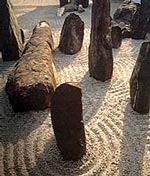Features:
· Constructed in confined space.
· Often only the most essential of elements represented.
· Borrows elements from tea gardens and zen viewing gardens.
· Creates the illusion of nature just outside or even entering the room.
· Popular in Edo period city homes of the merchant class.
The tsubo is a garden form familiar with many Americans. It’s style has been aped for all manner of nefarious purposes such as corporate office landscaping. This is the smallest of all gardens. Originally, the term tsubo referred to the small spaces between buildings or areas of a home. This is where these gardens are to be found; tucked into a corner or adding grace to a quiet entrance way or veranda. In Japan, tsubo were first developed as simple attempts to make transitional spaces more interesting; such as the nooks and crannies one passed walking around the grounds of a feudal castle. However, it was in the Edo era that the form of the tsubo flourished. In the cities, a new well-to-do merchant class was growing. Restricted by Shogunal law from showing their wealth in public, these nouveau-riche cultivated their appreciation of the arts (and gardens) in private. City houses were cramped elongated rectangles. Facing the street was the shop of the merchant. Further back was the reception room, and even further back were the private rooms for the family. These rooms were open to the outdoors at several points and connected by veranda walkways. Tucked between were the tsubo.
Tsubo can be created in almost any space and are an excellent “starter garden”. The elements are borrowed from both tea and Zen gardens Weathered stone lanterns, wash basins, gravel beds, small stone pathways and simple lush vegetation are typical. The merchants did not hold any awe for the purposes or symbolism of the elements they borrowed, but admired their beauty. A pathway in a tsubo, for instance, often is too small to walk on or leads nowhere except to a wall covered by a bush. The point is the beauty and the suggestion of greater space than what is there. Tsubo also offered city dwellers a chance to escape the dirt and confinement of the city by lending the illusion of being in the country or forest.

